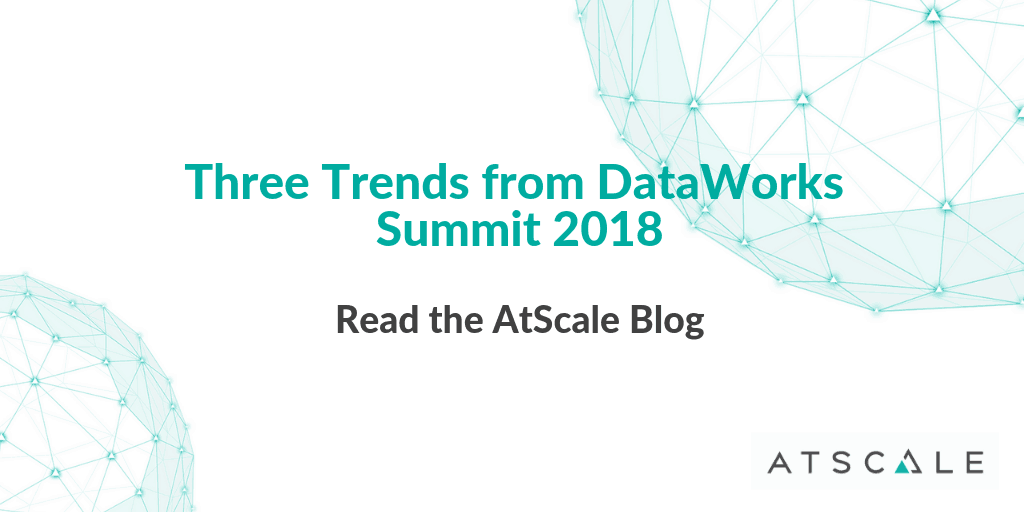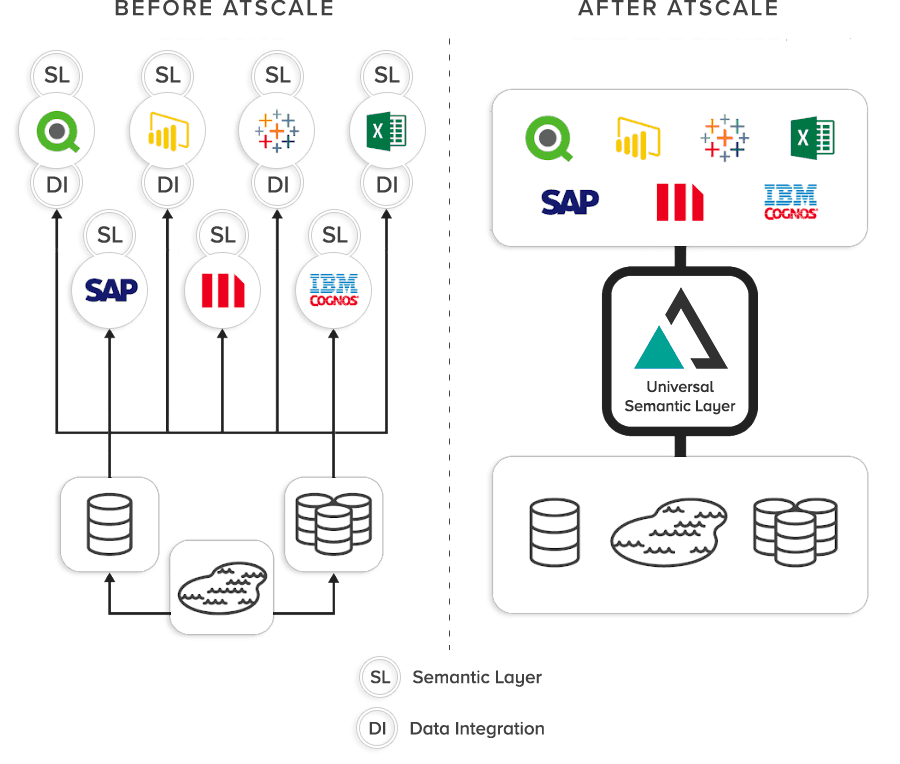
We did it again! The AtScale team was present at the Dataworks Summit 2018 in San Jose, California. We hope you had the opportunity to attend some, if not all, of the great sessions that we suggested. If you missed the event, don’t worry, we have prepared a great summary for you.
Insights. Ideas. Innovation
This was the major theme for the keynote this year. Hosted by John Kreisa (VP Marketing at Hortonworks), the keynote was energetic, fun and vastly informative. The four keynote presenters covered topics ranging from the World Cup to SQL, including demos, the unveiling of new technologies developed by the community and also analysis of the latest market trends.
THREE MOST RELEVANT TRENDS IN 2018
Customers are in charge
Insights-driven firms are winning
Exponential trends are still happening
Among the topics discussed, “Innovation” focused on cloud technologies. During the presentation we had the opportunity to participate in a poll to find out how much data are organizations moving to the cloud. Interestingly, the results were very similar to those obtained during our own AWS power sessions. There was a considerable balance between those who have not done anything about it and those who had moved just 25% of their data to cloud technologies.
How much data are you moving to the cloud?
What does this tell us?
Cloud technologies are innovative, economical, efficient and fast. However, like everything new, these technologies require change and humans by nature are very cautious when it comes to change. Moving your data and Business Intelligence (BI) to the cloud can represent a positive outcome on the economics and efficiency of processing, analysis and visualization of data in your organization, but is important to keep certain things in mind to make sure the migration is completed successfully.
As mentioned in previous posts, at AtScale we believe that the key elements to succeed with BI on the cloud are the following:
- Treat data as a shared asset
- Provide the right Interfaces for users to consume the data.
- Ensure security
- Establish a common vocabulary
- Curate your data
- Eliminate data movement
These are only few of the many best practices that you can exercise to ensure a good cloud experience for your BI users. To learn more about this topic check out our latest cloud-oriented white papers on our resources page.
Awards!
Shauna Davis receives the Datahero awards in behalf of TRAC Intermodal. Source: Hortonworks.
Hortonworks announced the Data Hero awards 2018 at Dataworks. We want to congratulate TRAC Intermodal on winning the Hortonworks Data Hero award in the Cognitive Honors category.
In an effort to become a data-driven company, TRAC Intermodal was able to complete a total transformation of their data platform, moving from outdated data management systems to a fully managed data lake environment. By using AtScale TRAC has disrupted the status quo — challenging the notion that data has to be brought to the user and that users need to learn how to use new BI technologies in order to ingest data from different sources. Instead, they have been able to leverage their staff’s BI skills, eliminate manual intermediary work, and, at the same time, elevate their business through utilizing the latest data technology platform.
Customers, customers, customers!
Standing room only, TRAC Intermodal and Canadian Tire share their use cases with the audience.
This event was definitely created by customers and with customers in mind, and we couldn’t agree more. We want to thank everyone who stopped by the AtScale booth to share their use cases with us. Special thanks to Aetna, TRAC Intermodal, and Canadian Tire for participating in the theater session where they shared the do’s and don’ts of BI on Big Data based on real experiences and real use cases.
Speaking of use cases, I had the great opportunity to demo our product to several folks who visited our booth. Interestingly, it was noticeable that there is still a lot of data movement going on out there. The good news is that complex ETL jobs and costly data replication exercises can be completely avoided by implementing a single semantic layer on your data architecture.
Before and After AtScaleOne of the most common use cases that was presented to me looked very similar if not the same as the graphic on the left hand side. Normally BI users (dashboard developers, analysts, etc.) need to ask their IT departments to generate data extracts and then move these extracts into smaller warehouses, where BI developers can analyze and visualize them, using their favorite BI tools.
In addition to this, each one of the BI tools used in the organization will require a different semantic layer and data integration process to make sure the BI users are able to interpret and analyze their data. The only problem with this, is what we call “Data Chaos”. Each one of these tools will generate a different result and BI analysts will spend more time trying to figure out which result is correct instead of gaining valuable insights from their data.
Data chaos is avoidable. The use of a single semantic layer allows you not only bring the users to the data but also let them analyze their data with the tools they love and are familiar with without having to spend time and money on slow and costly ETL and movement processes.
To conclude
We were very excited by the opportunity we had to attend this wonderful event. It was great to connect with customers and a lot of smart people in the BI industry, learn about real use cases and definitely help many understand how to succeed when doing BI on big data.
I hope you enjoyed this post. Stay tuned for more news about the events that we will be attending in the near future. See you soon!
To learn more about AtScale visit us at https://www.atscale.com/cloud

SHARE
Guide: How to Choose a Semantic Layer